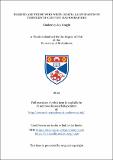Files in this item
Blessed are those who weep : gratia lacrymarum in thirteenth-century hagiographies
Item metadata
| dc.contributor.advisor | Andrews, Frances | |
| dc.contributor.author | Knight, Kimberley-Joy | |
| dc.coverage.spatial | 323 p. | en_US |
| dc.date.accessioned | 2015-07-28T09:23:26Z | |
| dc.date.available | 2015-07-28T09:23:26Z | |
| dc.date.issued | 2014-06-26 | |
| dc.identifier.uri | https://hdl.handle.net/10023/7046 | |
| dc.description.abstract | Hagiographies and canonisation processes from the thirteenth century are frequently saturated with descriptions of tears. The tears of holy men and women were both the means to, and apex of, spiritual perfection. Using hagiographical sources from the new Mendicant Orders emerging in Italy, France and the Low Countries, but drawing on other important examples when appropriate, this thesis demonstrates the complexity and importance of tears in thirteenth-century religious life. It makes significant contributions to understanding the construction of sainthood and the history of emotions during this critical period. Case studies of the beguine Marie d’Oignies (d.1213), and the founder of the preaching friars Dominic of Caleruega (d.1221), developed in chapters one and two allow for the meaning of tears to be explored fully and contextualised within the broader themes of devotional piety, gender, medicine and physiology, and the cult of saints. The hypotheses raised in these case studies are tested in chapter three using an extensive sample of vitae to demonstrate the importance of tears. In order to navigate the sea of tears, the study offers a bipartite conceptual framework that takes into account both a charismatic experience of tears (often known as gratia lacrymarum) and a progressive, transformative journey through tears. Building on Piroska Nagy’s seminal work Le Don des Larmes, this thesis presents a comprehensive analysis of tears in thirteenth-century hagiographies. It argues that they were not devalued in light of other forms of bodily piety nor did they become mere virtues in light of their proliferation; on the contrary, tears were highly valued and saturated religious life, traversing boundaries of what was to be imitated and admired. | en_US |
| dc.language.iso | en | en_US |
| dc.publisher | University of St Andrews | |
| dc.subject.lcc | BX4662.K65 | |
| dc.subject.lcsh | Christian hagiography--History--To 1500 | en_US |
| dc.subject.lcsh | Crying--Religious aspects--Christianity | en_US |
| dc.subject.lcsh | Spiritual life--Christianity--History of doctrines--Middle Ages, 600-1500 | en_US |
| dc.title | Blessed are those who weep : gratia lacrymarum in thirteenth-century hagiographies | en_US |
| dc.type | Thesis | en_US |
| dc.contributor.sponsor | Arts and Humanities Research Council (AHRC) | en_US |
| dc.type.qualificationlevel | Doctoral | en_US |
| dc.type.qualificationname | PhD Doctor of Philosophy | en_US |
| dc.publisher.institution | The University of St Andrews | en_US |
| dc.identifier.doi | https://doi.org/10.17630/10023-7046 |
This item appears in the following Collection(s)
Items in the St Andrews Research Repository are protected by copyright, with all rights reserved, unless otherwise indicated.

